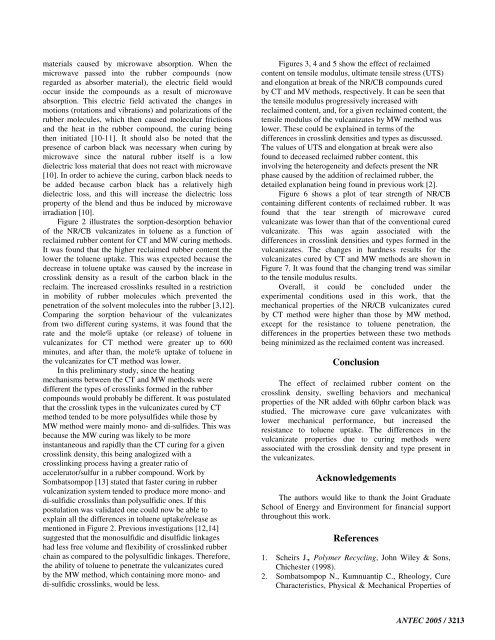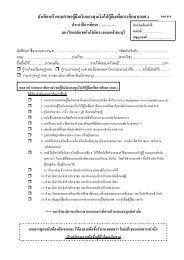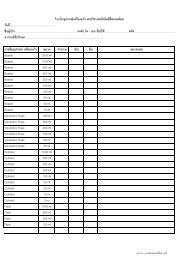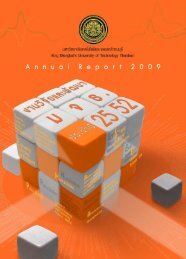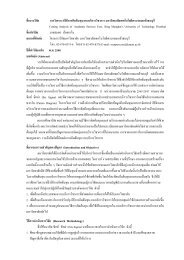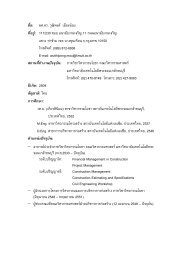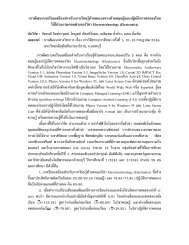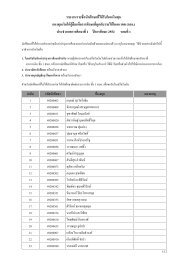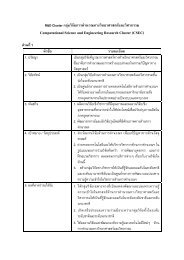Effect of Reclaimed Rubber Content in NR/Carbon Black ... - kmutt
Effect of Reclaimed Rubber Content in NR/Carbon Black ... - kmutt
Effect of Reclaimed Rubber Content in NR/Carbon Black ... - kmutt
You also want an ePaper? Increase the reach of your titles
YUMPU automatically turns print PDFs into web optimized ePapers that Google loves.
materials caused by microwave absorption. When the<br />
microwave passed <strong>in</strong>to the rubber compounds (now<br />
regarded as absorber material), the electric field would<br />
occur <strong>in</strong>side the compounds as a result <strong>of</strong> microwave<br />
absorption. This electric field activated the changes <strong>in</strong><br />
motions (rotations and vibrations) and polarizations <strong>of</strong> the<br />
rubber molecules, which then caused molecular frictions<br />
and the heat <strong>in</strong> the rubber compound, the cur<strong>in</strong>g be<strong>in</strong>g<br />
then <strong>in</strong>itiated [10-11]. It should also be noted that the<br />
presence <strong>of</strong> carbon black was necessary when cur<strong>in</strong>g by<br />
microwave s<strong>in</strong>ce the natural rubber itself is a low<br />
dielectric loss material that does not react with microwave<br />
[10]. In order to achieve the cur<strong>in</strong>g, carbon black needs to<br />
be added because carbon black has a relatively high<br />
dielectric loss, and this will <strong>in</strong>crease the dielectric loss<br />
property <strong>of</strong> the blend and thus be <strong>in</strong>duced by microwave<br />
irradiation [10].<br />
Figure 2 illustrates the sorption-desorption behavior<br />
<strong>of</strong> the <strong>NR</strong>/CB vulcanizates <strong>in</strong> toluene as a function <strong>of</strong><br />
reclaimed rubber content for CT and MW cur<strong>in</strong>g methods.<br />
It was found that the higher reclaimed rubber content the<br />
lower the toluene uptake. This was expected because the<br />
decrease <strong>in</strong> toluene uptake was caused by the <strong>in</strong>crease <strong>in</strong><br />
crossl<strong>in</strong>k density as a result <strong>of</strong> the carbon black <strong>in</strong> the<br />
reclaim. The <strong>in</strong>creased crossl<strong>in</strong>ks resulted <strong>in</strong> a restriction<br />
<strong>in</strong> mobility <strong>of</strong> rubber molecules which prevented the<br />
penetration <strong>of</strong> the solvent molecules <strong>in</strong>to the rubber [3,12].<br />
Compar<strong>in</strong>g the sorption behaviour <strong>of</strong> the vulcanizates<br />
from two different cur<strong>in</strong>g systems, it was found that the<br />
rate and the mole% uptake (or release) <strong>of</strong> toluene <strong>in</strong><br />
vulcanizates for CT method were greater up to 600<br />
m<strong>in</strong>utes, and after than, the mole% uptake <strong>of</strong> toluene <strong>in</strong><br />
the vulcanizates for CT method was lower.<br />
In this prelim<strong>in</strong>ary study, s<strong>in</strong>ce the heat<strong>in</strong>g<br />
mechanisms between the CT and MW methods were<br />
different the types <strong>of</strong> crossl<strong>in</strong>ks formed <strong>in</strong> the rubber<br />
compounds would probably be different. It was postulated<br />
that the crossl<strong>in</strong>k types <strong>in</strong> the vulcanizates cured by CT<br />
method tended to be more polysulfides while those by<br />
MW method were ma<strong>in</strong>ly mono- and di-sulfides. This was<br />
because the MW cur<strong>in</strong>g was likely to be more<br />
<strong>in</strong>stantaneous and rapidly than the CT cur<strong>in</strong>g for a given<br />
crossl<strong>in</strong>k density, this be<strong>in</strong>g analogized with a<br />
crossl<strong>in</strong>k<strong>in</strong>g process hav<strong>in</strong>g a greater ratio <strong>of</strong><br />
accelerator/sulfur <strong>in</strong> a rubber compound. Work by<br />
Sombatsompop [13] stated that faster cur<strong>in</strong>g <strong>in</strong> rubber<br />
vulcanization system tended to produce more mono- and<br />
di-sulfidic crossl<strong>in</strong>ks than polysulfidic ones. If this<br />
postulation was validated one could now be able to<br />
expla<strong>in</strong> all the differences <strong>in</strong> toluene uptake/release as<br />
mentioned <strong>in</strong> Figure 2. Previous <strong>in</strong>vestigations [12,14]<br />
suggested that the monosulfidic and disulfidic l<strong>in</strong>kages<br />
had less free volume and flexibility <strong>of</strong> crossl<strong>in</strong>ked rubber<br />
cha<strong>in</strong> as compared to the polysulfidic l<strong>in</strong>kages. Therefore,<br />
the ability <strong>of</strong> toluene to penetrate the vulcanizates cured<br />
by the MW method, which conta<strong>in</strong><strong>in</strong>g more mono- and<br />
di-sulfidic crossl<strong>in</strong>ks, would be less.<br />
Figures 3, 4 and 5 show the effect <strong>of</strong> reclaimed<br />
content on tensile modulus, ultimate tensile stress (UTS)<br />
and elongation at break <strong>of</strong> the <strong>NR</strong>/CB compounds cured<br />
by CT and MV methods, respectively. It can be seen that<br />
the tensile modulus progressively <strong>in</strong>creased with<br />
reclaimed content, and, for a given reclaimed content, the<br />
tensile modulus <strong>of</strong> the vulcanizates by MW method was<br />
lower. These could be expla<strong>in</strong>ed <strong>in</strong> terms <strong>of</strong> the<br />
differences <strong>in</strong> crossl<strong>in</strong>k densities and types as discussed.<br />
The values <strong>of</strong> UTS and elongation at break were also<br />
found to deceased reclaimed rubber content, this<br />
<strong>in</strong>volv<strong>in</strong>g the heterogeneity and defects present the <strong>NR</strong><br />
phase caused by the addition <strong>of</strong> reclaimed rubber, the<br />
detailed explanation be<strong>in</strong>g found <strong>in</strong> previous work [2].<br />
Figure 6 shows a plot <strong>of</strong> tear strength <strong>of</strong> <strong>NR</strong>/CB<br />
conta<strong>in</strong><strong>in</strong>g different contents <strong>of</strong> reclaimed rubber. It was<br />
found that the tear strength <strong>of</strong> microwave cured<br />
vulcanizate was lower than that <strong>of</strong> the conventional cured<br />
vulcanizate. This was aga<strong>in</strong> associated with the<br />
differences <strong>in</strong> crossl<strong>in</strong>k densities and types formed <strong>in</strong> the<br />
vulcanizates. The changes <strong>in</strong> hardness results for the<br />
vulcanizates cured by CT and MW methods are shown <strong>in</strong><br />
Figure 7. It was found that the chang<strong>in</strong>g trend was similar<br />
to the tensile modulus results.<br />
Overall, it could be concluded under the<br />
experimental conditions used <strong>in</strong> this work, that the<br />
mechanical properties <strong>of</strong> the <strong>NR</strong>/CB vulcanizates cured<br />
by CT method were higher than those by MW method,<br />
except for the resistance to toluene penetration, the<br />
differences <strong>in</strong> the properties between these two methods<br />
be<strong>in</strong>g m<strong>in</strong>imized as the reclaimed content was <strong>in</strong>creased.<br />
Conclusion<br />
The effect <strong>of</strong> reclaimed rubber content on the<br />
crossl<strong>in</strong>k density, swell<strong>in</strong>g behaviors and mechanical<br />
properties <strong>of</strong> the <strong>NR</strong> added with 60phr carbon black was<br />
studied. The microwave cure gave vulcanizates with<br />
lower mechanical performance, but <strong>in</strong>creased the<br />
resistance to toluene uptake. The differences <strong>in</strong> the<br />
vulcanizate properties due to cur<strong>in</strong>g methods were<br />
associated with the crossl<strong>in</strong>k density and type present <strong>in</strong><br />
the vulcanizates.<br />
Acknowledgements<br />
The authors would like to thank the Jo<strong>in</strong>t Graduate<br />
School <strong>of</strong> Energy and Environment for f<strong>in</strong>ancial support<br />
throughout this work.<br />
References<br />
1. Scheirs J., Polymer Recycl<strong>in</strong>g, John Wiley & Sons,<br />
Chichester (1998).<br />
2. Sombatsompop N., Kumnuantip C., Rheology, Cure<br />
Characteristics, Physical & Mechanical Properties <strong>of</strong>


